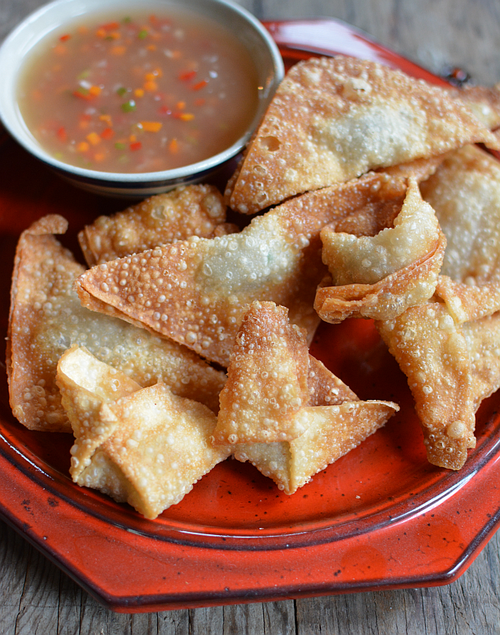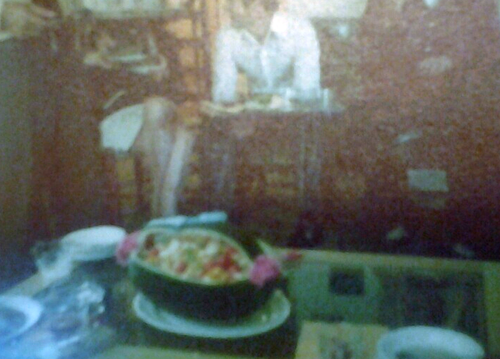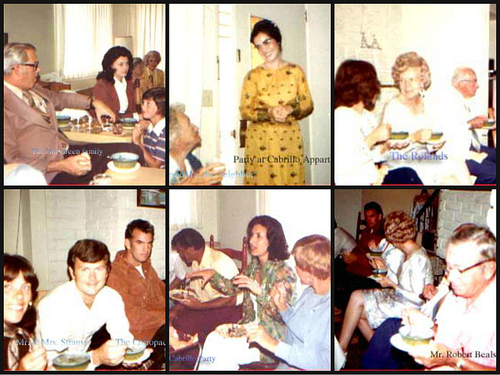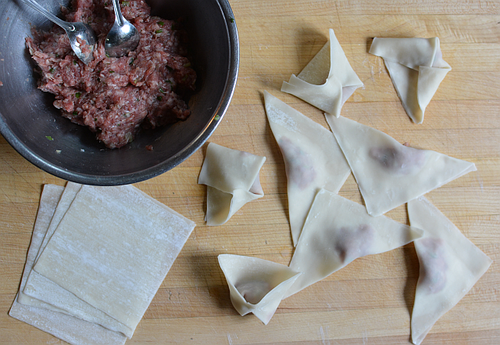Wontons are the first dumplings that I learned to make. My mom entrusted me to make them for parties and other family gatherings. She fried them and served them with a Viet-style sweet and sour sauce speckled with a confetti-like bits of vegetables. It was finger food that got eaten up in a flash. That’s why our family wrapped regularly 3 or 4 packages worth of wontons for a total of roughly 200 wontons. Last Friday I made a small batch for our TGIF cocktail hour. There were leftover wrappers and I thought about how growing up, fried wontons were on my mom’s rotation of favorite foods to make.
It was for good reason. In 1975 we discovered that fried wontons were a friendly food in America . Fresh from the refugee resettlement camps, my parents decided to make San Clemente, California, our home. We were oddballs in the Southern California beach community known for surfing and Richard Nixon’s Western White House. Back then, San Clemente’s population was about 20,000 people, most of whom were White.
With no car, we initially walked everywhere from our apartment on Cabrillo Avenue. It was a 5-bedroom, 2-story apartment house – spacious enough for our family of seven with a spare room for my mom to operate a small tailoring business. It was close to Del Mar Avenue, the main drag. We got around and locals noticed us.
The Vietnam War was fresh in America’s collective memory and Camp Pendleton Marine Base where the first wave of Vietnamese refugees arrived was 10 minutes away. In May 1975, Time magazine reported that only 36 percent of Americans thought that Vietnamese refugees should be allowed to live in the U.S. That was not the case in our situation.
People were extremely kind to us when we arrived. There was an incredible outpouring of support from locals – churches, neighbors and small business owners. Many became instant friends to our family, showing us the ropes and welcoming us.
A few months after we arrived in town, my parents hosted a “Thank You” party. We had little furniture and borrowed TV trays and chairs from the neighbors. My mom marshaled us kids to help with the menu of fried wontons, cucumber and shrimp salad (my oldest sister Yenchi peeled each cucumber with a knife because we didn't know what a peeler was!), crab and asparagus soup, a fancy version of chicken back and celery rice, and a carved watermelon filled with melon and fruit cocktail (her substitute for tropical fruit found in Saigon).
She and my dad wanted to serve Vietnamese food to our new American friends. She used and adapted ideas from the little orange notebook. “Some of the guests felt sorry for us because we seemed like poor refugees,” my mom said the other day. “But your dad and I wanted to show them that we were dignified people who appreciated them.”
I asked my dad dig up photos from the “Cabrillo Apartment Party” and he obliged.
Along with the photos, Bo Gia sent along notes about who attended the party:
- Mrs. “Grandma”, an older woman Cabrillo neighbor who baked sweets for everyone on the street.
- Mrs. “Aunt’ Lucy, a retired teacher who after reading an article about our family in the Orange County Register, contacted us and said she considered us as her adopted family. She gave us a lot of love and care.
- Mr. and Mrs. Robert Beals, who had been in Viet Nam for his export business, introduced us into the new life in America.
- Mr. and Mrs. James Green and their son, members of the Mormon church, helped to get us to be in contact to start the sewing business. Mr. Green, a barber, led us to Tony Di Giovanni pawn shop. Mr. Di Giovanni was the town mayor and local banker too. Your mom got her second-hand home sewing machine at the pawn shop to start her business.
- Mr. and Mrs. Roland also read about us through the local newspaper. Mr. Roland had been in Viet Nam for the insurance business. Mrs. Roland let me use her big Plymouth car before I got an official driver’s license! Having a car in California is important and she introduced us to a friend to buy our first car, a Ford Mercury Comet for $350.
- Mr. and Mrs. James Strauss managed the apartment complex where we rented. He introduced me into the insurance business. He was a wounded Viet Nam War veteran and later helped us to buy our first house on San Carlos Avenue.
- Mr. and Mrs. Holder. He was a chiropractor who liked to dive. One time he gave us fresh abalone he caught from Dana Point Harbor.
- Also in attendance were my older brothers Bác Thảo and Bác Thanh and our good family friend Chú La Trọng Mỹ. We had twenty-four people there that day, including our family.
Those fried wontons, my mom noted in a follow-up phone call, became a favorite with some of our new friends. “Mrs. Yetso, the wife of a local real estate man and a former beautician herself, loved those wontons. They helped us out so much, giving us practical second-hand things like the washer and dryer. Bo Gia and I still use the bedside lamps they gave us. In return, our family regularly gifted her fried wontons. Mrs. Yetso had these scary super long, sometimes curly finger nails but she deftly managed to eat up all the wontons.”
My mom, dad and I had good laughs remembering the “abrillo Apartment Party. We were among the first Vietnamese refugees to resettle in America. Those times in the mid 1970s were filled with wonderment. We were launching new lives and didn’t know how things would turn out. If it wasn’t for so many people stepping up to help, our transition would have been extremely rough.
Below are my family’s recipes for the wontons and sweet and sour sauce. You can fold the wontons however you’d like but triangles are the easiest.
RECIPE
Fried Wontons
Hoanh Thanh Chien
Yields: About 48 wontons, enough for 6 to 8 as an appetizer
Ingredients:
- 8 ounces (225 g) ground pork
- 1 slender green onion, finely chopped
- 1 small clove garlic, minced
- ½ teaspoon cornstarch
- ½ scant teaspoon salt
- ⅛ teaspoon sugar
- ⅛ teaspoon black pepper
- 48 wonton skins (one package)
- Canola or other neutral oil, for deep-frying
- Sweet and sour sauce (see “Note” for recipe)
Method
- For the filling, combine the pork, green onion, garlic, cornstarch, salt, sugar and black pepper in a small bowl. Mix well then set aside.
- On your work surface, lay the wonton skins out, about 6 to 8 at a time. Use two teaspoons or demitasse spoons to place a scant teaspoon (about the size of a ½-inch marble) of filling in the center of each square. Dip a pastry brush in water and lightly brush the edges of each square. Pick up one corner and fold it over to make a triangle. Press the edges with your finger to seal. Place the finished wonton on a large plate or tray. Repeat until all the filling is used up.
- Fry the wontons in a wok or deep skillet. Pour enough oil to depth of 11/2 inches. Heat the oil to 325 to 350F (160 to 180C) on a deep-fry thermometer. As the oil heats up, place a baking sheet with a cooling rack set inside next to your stove to cool the fried wontons. When the oil is sufficiently hot, fry the wontons in batches, as many as may comfortably fit in the pan at a time. Before adding each wonton to the oil, make sure the edges are sealed and use your finger to press out any air bubbles. Fry each to a luscious golden brown, about 2 minutes per side. Transfer each from the hot oil to the cooling rack. Place on a large platter and serve with the dipping sauce.
Note: For my family’s homemade sweet and sour sauce, in a small saucepan, bring the following to a boil: 1 ½ cups water, 1 tablespoon finely chopped onion, 1 small finely minced garlic clove, 3 ½ tablespoons sugar, 2 tablespoons distilled white vinegar, 1 ½ tablespoons fish sauce, ¼ teaspoon salt, ⅛ teaspoon white pepper. Simmer for 5 minutes then stir in 1 ½ tablespoons cornstarch dissolved in 2 tablespoons water. When thickened, take off heat and stir in: 1 tablespoon chopped green onion, 1 tablespoon finely chopped carrot, and 1 ½ tablespoons finely chopped red bell pepper. Let cool for 10 minutes then taste and tweak. Serve slightly warm or at room temperature.
Recipes abridged from Into the Vietnamese Kitchen.
Related posts on April 30, 1975:
- Revisiting the Fall of Saigon 40 Years later - how my family and others escaped
- Chicken Back and Celery Rice Recipe - a ghetto-ish but luxe dish we made when we first came to America in 1975
- Cooking Vietnamese Food in 1970s America: Things We Were Grateful For - drinking water for one...
- Inside My Mom’s Book of Domesticity: Recipes and Stories - what she brought from Vietnam, how I was inspired to write cookbooks
- Revisiting Saigon Now: Memorable People and Places - what the future holds for Saigon residents now




















